John Brownell Rogers, 1863 - 1937
by Brian Stevenson
last updated May, 2025
J.B. Rogers was an educator, a Methodist minister, and industrial consultant, living at various locations around New York, Vermont, and Pennsylvania, USA. He stated that his favorite hobby was “microscopy”, and was primarily an amateur slide-maker. From around 1905 onward, he was a part-time public relations representative and Director of Research for the dental hygiene company Dentinol and Pyrodize Co. / Pyorrhocide Clinic, and prepared microscope slides with that business’ products. He likely gave those slides away during promotional meetings.
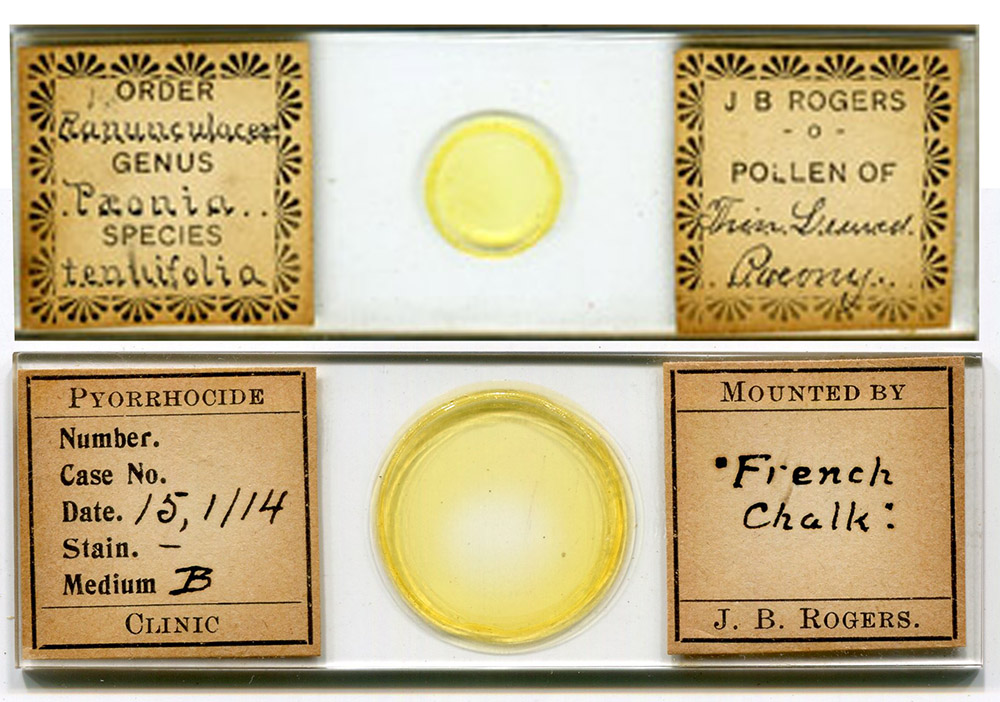
Figure 1.
Slides by J. Brownell Rogers. The lower slide is dated January 15, 1914 and the printed label states “Pyorrhocide Clinic”, an agency of The Dentinol and Pyrodize Company. Rogers presented talks on the company’s products, and may have distributed such slides at those meetings.
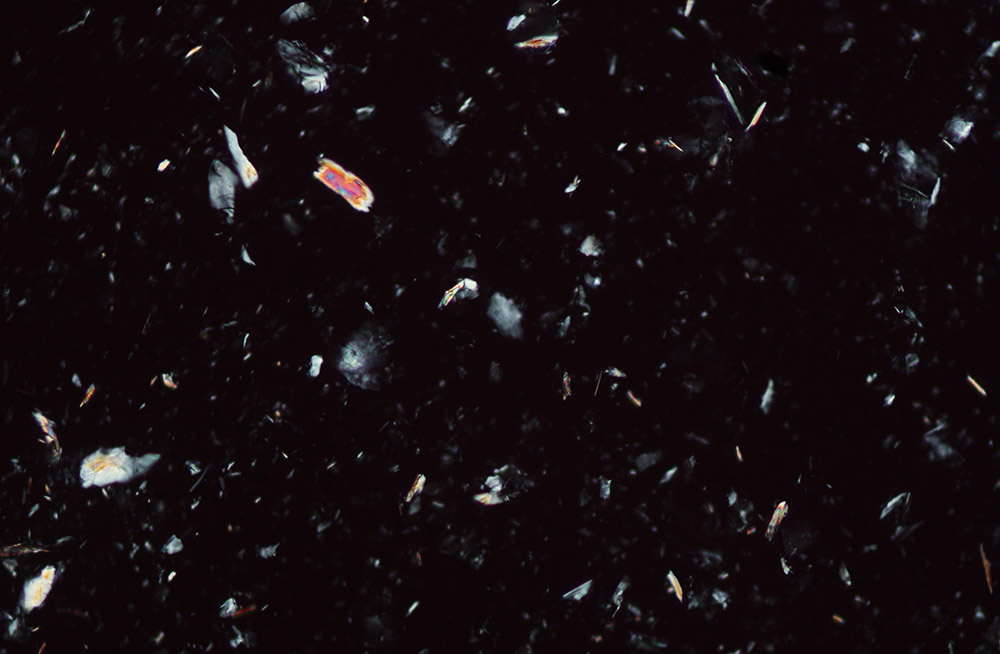
Figure 2.
“French chalk”, mounted in Balsam by J.B. Rogers (see Figure 1). Photographed with a 10x objective lens, crossed polarizing filters, and a C-mounted digital SLR camera on a Leitz Ortholux II microscope.
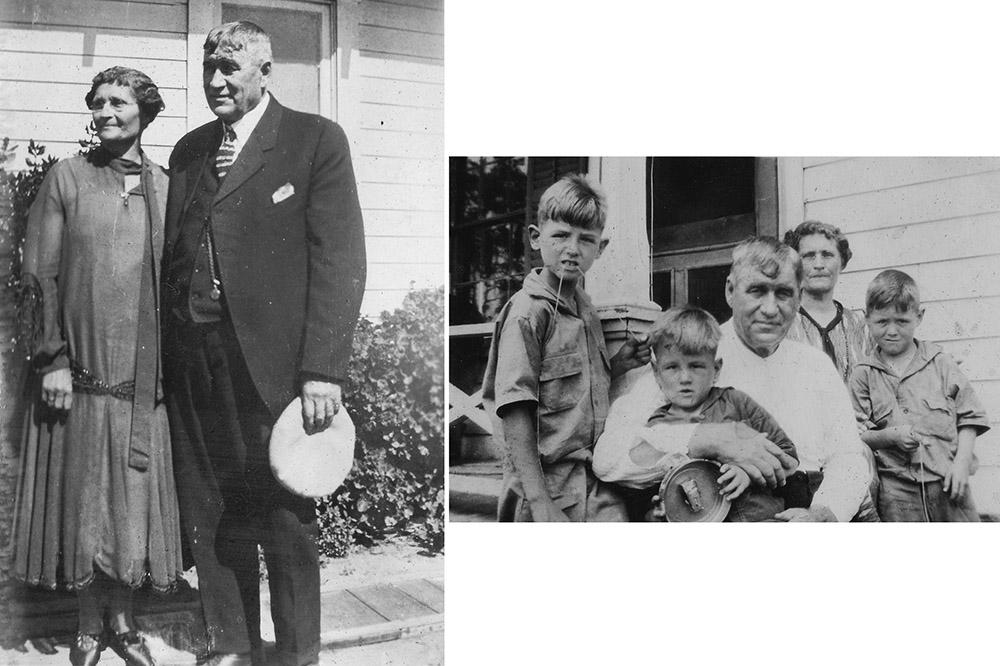
Figure 3.
Photographs of J. Brownell Rogers and his wife, Vesta, and their three sons. Adapted for nonprofit, educational purposes from ancestry.com
John Brownell Rogers was born on April 21, 1863, in Greenwood, N.Y. He evidently preferred to use his middle name, as the 1880 federal census listed him as “Rogers, Brownell”, and most of his contemporary writers referred to him as “J. Brownell Rogers”. He was the eldest child of William W. and Elizabeth Rogers. The father was a minister, an occupation that was also followed by Brownell.
Rogers attended Syracuse University, graduating with an A.B. in 1889. He then attended the Vermont Methodist Seminary, in Montpelier, receiving his A.M. in 1892. While studying at the seminary, he also taught “Natural Science and Higher Mathematics”.
He picked up the hobby of microscopy while in college, if not earlier. He certainly owned a microscope in 1888, as evidenced by a letter to The Microscope magazine in 1890, on “fossil wood”: “Two years ago, while spending a vacation at home, I was visiting a gentleman who had travelled through the western States quite extensively. In the course of our conversation mention was made of the mineral resources of the west. A box containing specimens of minerals and other things which he had picked up during his trips was brought out, and we spent some time examining them. My attention was attracted by a specimen of ‘petrified wood’ which he obtained in Colorado. Instead of being solid and compact it seemed to be fragile, and I noticed that it could be split into small, thin plates - excellent longitudinal sections. Breaking off one of the plates, I took it home with me and examined it under my microscope. So beautiful was the perfection of the object that I could scarcely make myself believe that I was looking at a piece of fossil wood; so I put it into hydrochloric, boiled it, and again examined; there was no destruction of the delicate cell markings; then nitric acid was used, and still the specimen remained unchanged. Then its hardness was tested, and although it was very brittle, it readily scratched glass. Other tests showed that it was silicified wood. The next morning I again called on the gentleman, showed him the object under the microscope, and secured the entire specimen. A blow of the hammer was sufficient to break it into long slivers which by being bent back and forth in the hands were easily broken up into magnificent sections thinner than could be obtained by considerable grinding. Sorting out the pieces suitable for mounting, I washed them in hydrochloric acid, water, alcohol, turpentine, and mounted in balsam.”
He shared mounted samples of this fossilized wood with the editors of popular microscope magazines. The Microscope wrote, “Mr. J.B. Rogers, Montpelier, Vt., for a mounted section of silicified wood from Colorado. Here every portion of the woody structure has been replaced by the fossilizing silica, even to the smallest dot or line or depression. The cell markings are so distinct that they may be satisfactorily examined with a high power objective, when they become as sharply defined as in a section of living tissue. Nature has taken away the wood and substituted its perfect image in stone. It is wonderful”. The American Monthly Microscopical Journal wrote, “We return thanks to the donor for the following interesting slide: Silicified wood from Colorado, evidently one of the Coniferae, as is seen from the cell-wall markings. Prepared by Prof. J. Brownell Rogers, Montpelier, Vt.”
Leaving Vermont, Rogers taught Natural Science at the Erie, Pennsylvania High School from 1890 through 1892. During that time, he also served as President of the Erie Natural History Society.
Brownell married Vesta Clair on July 8, 1891, in Willing, New York. The couple had six children, three boys followed by three girls. One of the girls died in infancy.
Having completed his A.M. in 1892, Rogers began ministering. He served at Methodist Episcopal churches at Conquest, New York from 1892 to 1895, New Hope, New York from 1895 to 1898, and Freeville, New York from 1898 until 1900.
During this time, he wrote an article that described the Genesse River valley in lay terms, which was published in Science. Standards for publication in that journal were significantly lower in those days!
In 1900, Rogers took on the role of Superintendent of Instruction of the George Junior Republic, located in Freeville. This was a charitable farming program for young boys and girls, who came from the streets of New York City, to live away from the poverty and crime of the City, and to learn responsibility.
Descriptions of the Junior Republic tell us that Rogers owned a printing press and type, “Previous to 1900, much of the Republic Printing work had been done at the home of Mr. J. Brownell Rogers, Superintendent of Instruction, in Freeville. He owned twenty fonts of type and a small hand press, on which letter heads and cards were printed. In February, 1900, Mr. Rogers brought his printing outfit up to the Republic, and it was installed in a small building next to the Carpenter Shop.”
Rogers moved to Van Etten, New York in 1904, to take on ministry to their Methodist Episcopal Church.
In 1909, he became Principal of the High School of Freeville, New York, and remained in that position for many years.
Around that same time, Rogers became involved with the Dentinol and Pyrodize Company, of New York City. The company produced dental hygiene products, such as “Dentinol” and “Pyorrhocide”, for consumer use at home, as well as apparatus for dentists (Figure 4). They founded “Pyorrhocide Clinic” in 1908, to study pyorrhea (now better known as “periodontal disease”) and develop new treatments (Figure 5). An 1937 summary of Brownell Rogers' life stated that he was “for 33 years director of the research department of Dentinol and Pyrodize Company”. Rogers also traveled to make presentations for the company; Figure 6 shows an 1916 announcement of one of his talks, to the Young Women’s Christian Association of Minneapolis, Minnesota. For the 1930 national census, Rogers described his occupation as “educational writer – pyorrhea”.
He may have continued preaching in a less defined role, considering that the 1920 census listed Rogers’ occupation as “clergyman”.
J. Brownell Rogers died on January 2, 1937, at the age of 73, in Freeville, New York.

Figure 4.
Some products of the Dentinol and Pyrodize Company. Adapted for nonprofit, educational purposes from https://americanhistory.si.edu/collections/object/nmah_731141, https://ehive.com/collections/5254/objects/595011/chemical-dentinol-pyorrhea-treatment, and internet sale sites.
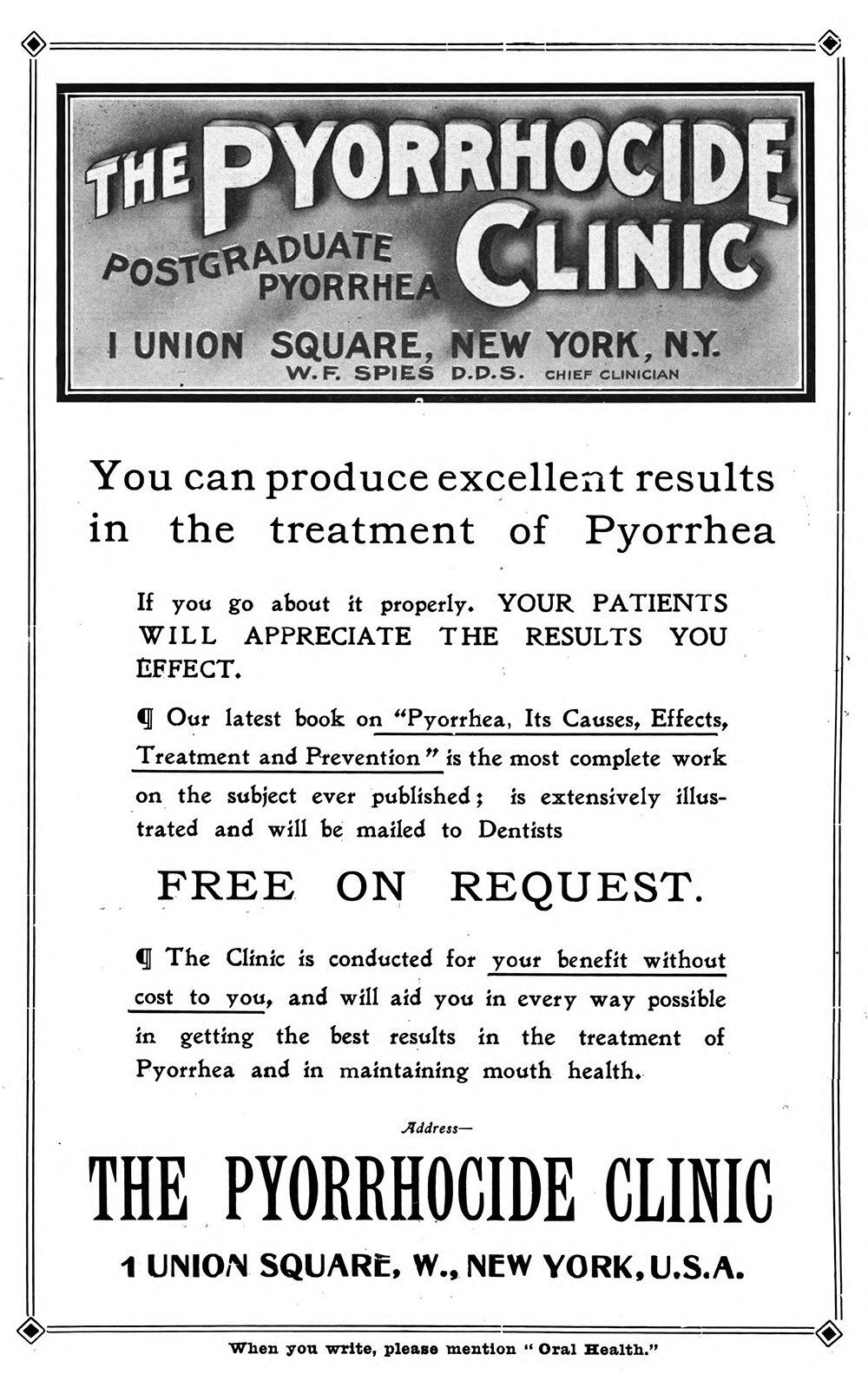
Figure 5.
A 1912 advertisement for the Pyorrhocide Clinic, from “Oral Health”.
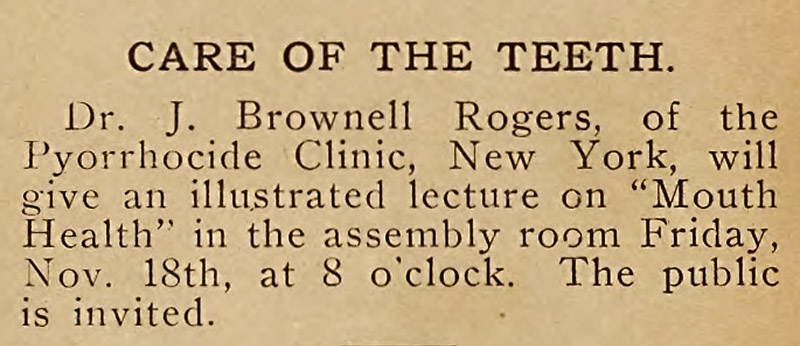
Figure 6.
A 1918 announcement of a talk by J. Brownell Rogers on “Mouth Health”, from “Good Cheer” (Minneapolis, Minnesota).
Resources
Alumni Record and General Catalogue of Syracuse University (1899) John Brownell Rogers, page 442
Alumni Record and General Catalogue of Syracuse University (1911) John Brownell Rogers, page 774
The American Monthly Microscopical Journal (1890) Slides received, Vol. 11, page 15
Baldwin, Milton F. (1911) History of the print shop,
Junior Republic Citizen, Vol. 14, pages 163-164
The Cosmopolitan (1918) Advertisement for Pyrrhocide, Vol. 65, page 108
Electrical Engineer (1892) “Forming an electrical club at Erie, Pa. About fifty young men of our city, most of them engaged in our electrical manufacturing establishments, have organized as ‘The Erie Electrical Club’, for the purpose of studying the principles and phenomena of electricity. We have engaged Prof. J. Brownell Rogers, of the High School faculty, to deliver a course of 12 lectures on electricity. We meet each Thursday evening in Prof. Rogers' laboratory at the High School where we have all the advantages of apparatus and the use of the Edison incandescent circuit for experiment”, Vol. 13, page 204
Good Cheer (1916) Care of the teeth, November issue, page 1
The Microscope (1890) Acknowledgement, Vol. 10, page 117
Oral Health (1912) Advertisement for Pyrrhocide Clinic, Vol. 2
Rogers, J. Brownell (1890) Fossil wood, The Microscope, Vol. 10, pages 378-379
Rogers, Brownell (1893) The Genessee River, Science, Vol. 21, page 121
Rogers, J. Brownell (1894) The preservation of material, The Methodist Review, Vol. 76, pages 643-644
Rogers, J. Brownell (1902) The smallest republic, Presbyterian Banner, Vol. 88, pages 8-9
Rogers , Lowell Lincoln (1931) Brownell Genealogy 1619-1930, The Ancestors and Descendants of Veranus Brownell Itinerant Methodist Preacher, The Anco Art Press, Webster, N.Y., page 47





